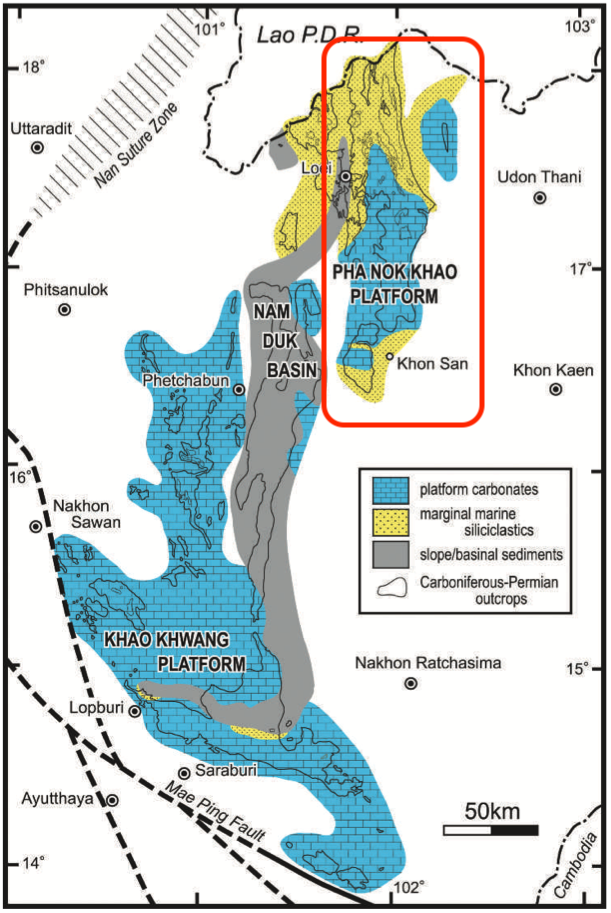E-Lert Fm
Type Locality and Naming
Pha Nok Khao Platform (Loei region): The type section is designated at Huai E-Lert Reservoir (also called Huai Sampod) east of Wang Saphung in Loei Province (DMR 1992). Originally introduced by Charoenpravat & Wongwanich (1976) and Charoenpravat et al. (1984). A middle formation in the Loei Gr.
Synonym:
[Figure: Late Paleozoic major facies subdivisions on the western margin of the Indochina Block by Ueno and Charoentitirat (2011). (Slightly modified from Wielchowsky & Young 1985).]
Lithology and Thickness
"Shale, siliceous shale (sometimes identified as chert in the field) and sandstone with locally developed impure bedded limestone and various-sized limestone blocks. Much of the succession is considered to be turbidites. … The whole of the formation at its type section has not been measured, although Ishibashi et al. (1996) illustrated a stratigraphic log of a 45 m thick part of the section." [Ueno and Charoentitirat (2011)]
Relationships and Distribution
Lower contact
Previously widely accepted that the E-Lert Formation simply overlies the Nam Mahoran Fm; but now it is known that it is partly a coeval facies.
Upper contact
Essentially underlies the Pha Dua Fm.
Regional extent
The formation outcrops in a north – south belt at least 80 km long on the west side of the Chiang Khan–Loei–Wang Saphung–Khon San Highway (Route 201).
[Figure: Distribution of Carboniferous and Permian in NE Thailand. Data mainly based on 1:1 million scale geological map of Thailand (DMR 1999) with minor modifications (Ueno and Charoentitirat 2011).]
GeoJSON
Fossils
Fusulines Laosella methikuli, L. parva and L. loeyensis and brachiopods Purdonella magna and Brachythyrina strangwaysi were reported from the type section, which indicated an early Middle Permian (Kubergandian) age of the formation. Ammonoids Agathiceras aff. suessi, Properrinites boesei, Popanoceras sp., Propinacoceras sp. and Artinskia loeiensis were interpreted as early Early Permian (Sakmarian). Latest Carboniferous (Gzhelian) to earliest Permian (Asselian) radiolarians representing the Pseudoalbaillella bulbosa Assemblage .. and Early Permian (probably Sakmarian–Artinskian) radiolarians and ammonoids from this formation." [Condensed from Ueno and Charoentitirat (2011)]
Age
Depositional setting
"It represents deeper-marine strata formed in a slope-to-basin environment on the Pha Nok Khao Platform, which is probably the northern continuation of the Nam Duk Basin."
Additional Information
